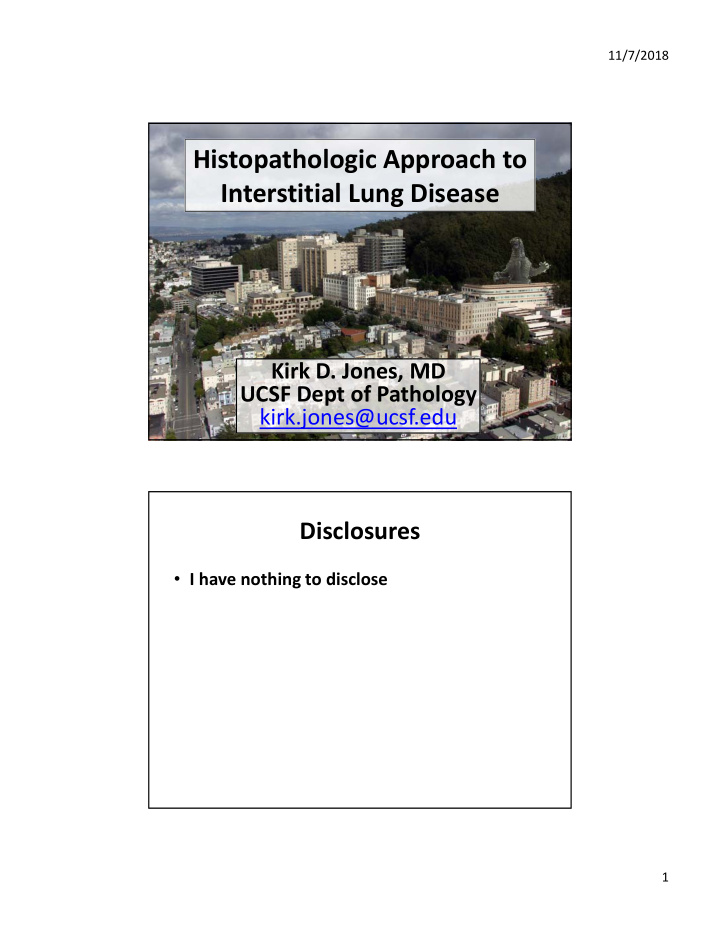



11/7/2018 Histopathologic Approach to Interstitial Lung Disease Kirk D. Jones, MD UCSF Dept of Pathology kirk.jones@ucsf.edu Disclosures • I have nothing to disclose 1
11/7/2018 Why? • Much of interstitial lung disease biopsies are being supplanted by HRCT analysis and clinical diagnoses: UIP, HP, CTD • The biopsies that are being performed are the strange cases, and will likely be more difficult. Overview • Normal lung anatomy • Patterns of fibrosis • Some side trips along the way to discuss Acute lung injury Granulomas 2
11/7/2018 Normal Lung • The lung is divided into numerous lobular units that have a characteristic appearance. – Arteries run with airways. – Veins present in interlobular septa. – Lymphatics in bronchovascular bundles, interlobular septa, and pleura. The Pulmonary Lobule 3
11/7/2018 4
11/7/2018 Pattern of Fibrosis • The distribution of the fibrosis will often correlate with the nature of the injury. • Bronchiolocentric fibrosis – tends to occur in diseases with inhalation injury (HP, RB, fume) or bronchiolar inflammation (CTD) • NSIP – tends to occur in diseases with diffuse alveolar inflammation (autoimmune CTD, drug reaction, HP) • UIP – odd peripheral distribution pattern. Possibly related to aberrant senescence with most distal cells either more predisposed to stretch injury, or least likely to be replenished. Bronchiolocentric Fibrosis • Fibrosis of the peribronchiolar alveolar septa – Peribronchiolar metaplasia – Lambertosis – Bronchiolization of alveolar ducts • May see associated mucostasis or distortion of central portion of lobule 5
11/7/2018 6
11/7/2018 7
11/7/2018 8
11/7/2018 Bronchiolocentric Fibrosis • Look for lace‐like central regions (fireworks) of peribronchiolar metaplasia • Think about inhaled diseases (HP, RB, fume inhalation injury) and diseases with small airway inflammation (aCTD) 9
11/7/2018 Case 1 • 49‐year‐old woman with shortness of breath for 6 months. • Works as a dog walker. Some mold exposure in apartment. Uses a down pillow. Smokes (marijuana with vape pen). • CT shows centrilobular consolidation and GGO 10
11/7/2018 11
11/7/2018 12
11/7/2018 Case 1 ‐ Diagnosis • Giant cell interstitial pneumonia • Hard metal pneumoconiosis • Exposure to tungsten cobalt Sawblade sharpener, diamond polisher, foundry worker China cases Dental lab tech Vape pen? Cloud Competition: Vapor Dynasty Expo 2015 13
11/7/2018 Bronchiolocentric Fibrosis • Recognize by central changes Peribronchiolar metaplasia Mucostasis and distortion • Build your differential based on inhalation versus airway inflammation Smoking (RB, PLCH) Inhalation/aspiration (fume or food) Occupational (pneumoconiosis, “popcorn lung”) Some systemic diseases (CTD, IBD) due to airway inflammation Some idiopathic cases (fibrosis, OB, DPB) Nonspecific Interstitial Pneumonia (NSIP) • Diffuse alveolar septal thickening by either inflammation (cellular NSIP) or fibrosis (NSIP‐ fibrosis) • Can be variable, but should show fibrous thickening of the alveolar septa in peribronchiolar, subpleural, and midzones of the lobule. 14
11/7/2018 Dusty Cobweb Fibrosis Term by Kevin Leslie 15
11/7/2018 NSIP Pattern • Look for variable but diffuse alveolar septal thickening (dusty cobweb) by fibrosis or inflammation • Look for additional clues to help decide the differential (lymphoid aggregates, granulomas, pleuritis, vessel thickening). 16
11/7/2018 If my pathologist tells me the biopsy shows NSIP, then my job has only just begun. Case 2 • 44‐year‐old woman with relatively abrupt onset of shortness of breath following trip to Ireland. • Treated for pneumonia. Mild improvement, but still dyspneic after one year. 17
11/7/2018 18
11/7/2018 Back to Case 2 • Diagnosed with cellular and granulomatous interstitial pneumonia. • Follow‐up: 6 years later (including 5 year post‐op mark) 8 years later… 19
11/7/2018 20
11/7/2018 Case 2 • Cellular NSIP with granulomas progressing to fibrotic NSIP, transplanted, then recurred in the donor lung. • Hot‐tub lung (M.avium) 21
11/7/2018 Nonspecific interstitial pneumonia (NSIP) • Recognize by involvement of all zones of lobule without significant architectural destruction • Build your differential based on systemic (or diffuse) inflammation: Connective tissue disease Drug reaction Hypersensitivity pneumonia (with br‐centric accentuation) • Modify Based on Other features Lymphoid aggregates – CTD, smoking, drug Granulomas – HP, rare CTD, rare drug, infection Usual Interstitial Pneuumonia UIP Pattern • Fibrosis beginning at the periphery of the lobule • Temporal and spatial heterogeneity • Temporal (“HORN”) – Honeycombing, old (dense collagen) fibrosis, recent (fibroblast foci) fibrosis, and normal • Spatial – worse subpleural, paraseptal, and basilar 22
11/7/2018 23
11/7/2018 24
11/7/2018 25
11/7/2018 26
11/7/2018 The “Tip Test” • Since UIP shows peripheral lobular accentuation of fibrosis, the very tip of the surgical biopsy is often obliterated by fibrosis (often with overlying fatty metaplasia of the pleura) • NSIP tends to show normal alveolar architecture (with thickened septa) at the tip of the biopsy. 27
11/7/2018 Case 3 • 56‐year‐old woman with several years history of dry cough and CT scan with “reticulation”. Her mom died of pulmonary fibrosis in her early 60’s due to “lupus”. 28
11/7/2018 29
11/7/2018 Case 3 • Patient’s blood sent to UT Southwestern to Dr. Christine K. Garcia. • TERC mutation • Familial IPF (although at least partially not “idiopathic”) 30
11/7/2018 UIP Pattern • When there is “true” temporal heterogeneity, the diagnosis is almost certain • Use the “Tip Test” • Build differential based on abnormal senescence and injury patterns • Rare cases of HP, CTD may show UIP pattern Look for central scarring and granulomas in HP Look for increased lymphoid aggregates and lack of normal (NSIP instead) in CTD Take Home Message • Differing patterns of fibrosis can help to guide the differential diagnosis. – Bronchiolocentric pattern – NSIP pattern – UIP pattern • The pathology is just one component of the multi‐disciplinary diagnosis. 31
Recommend
More recommend